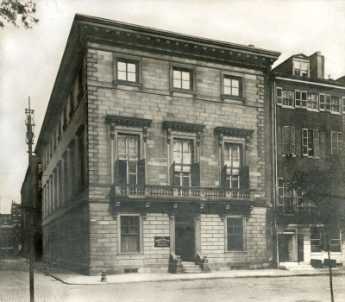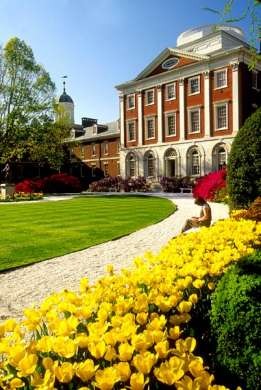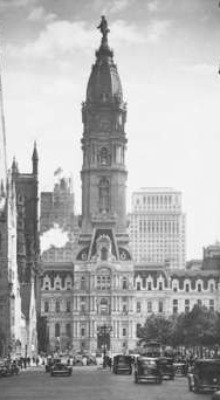Related Topics
Tourist Walk in Olde Philadelphia
Colonial Philadelphia can be seen in a hard day's walk, if you stick to the center of town.
Sixth and Walnut to Broad and Samson
 In 1751, the Pennsylvania Hospital at 8th and Spruce was 'way out in the country. Now it is in the center of a city, but the area remains dominated by medical institutions. 
|
| Dr. Fisher |
As you emerge from the Curtis Building, it is worth a half-block detour to 7th and Samson to glance at Jeweler's Row, a curious concentration of diamond merchants who have clustered there since before the Civil War. However for this leg of the tour, turn about to Washington Square, now a quiet manicured residential square but once the site of the Walnut Street prison, the location of the first balloon ascension, the potters field of colonial days, and the home of the unknown soldier of the Revolutionary War. There are accounts of people catching abundant fish in a brook once running through the square, well into the Nineteenth Century. Because of the brook, there were tanneries in the region; tanneries always smell bad. Accordingly, the deed from the Penn family for the Pennsylvania Hospital nearby is revocable if anyone ever decides to build another tannery on its grounds.

|
| Athenaeum of Philadelphia |
On Sixth Street, a few feet south of Walnut, is the splendid brownstone Italianate structure of the Athenaeum, established just after the Revolution as a private lending library, and continuing to today. It's well worth a brief visit to grasp why Lafayette joined it, and so many other members have contributed Nineteenth Century, mostly French, sculpture and paintings. Next door is the former home of then-Mayor Richardson Dilworth. It looks vaguely Georgian in style but was actually built forty years ago as Dilworth's personal statement that Society Hill needed to be revived as a fine place to live. Although Charles Peterson is credited with the idea of starting Society Hill by restoring Stephen Girard's house at Third and Spruce, Peterson bought it for $1800 and eventually sold it for millions. By contrast, Dilworth spent millions for his house, and it later sold for much less. Although they served the same cause, the two men of entirely different social class were always rather reserved with each other.
Cross the grassy Washington Square, turning left on Seventh Street. Until 1980, this area was the home of publishing, mainly medical publishing, but now publishing's loft buildings have been converted to condominium apartments. The penthouses on the top of these buildings are invisible from the street, but are truly spectacular.
Spruce Street itself is a sort of architectural museum, with houses on the Delaware dating to 1700, getting progressively more recent as you go West. At the level of Seventh Street, the houses date from around 1810, eventually reaching Broad Street around 1890. Midway up the block of Spruce Street from 7th to 8th on the North Side (the South Side is nothing but a facade, covering hospital buildings) is the house --really two houses run together -- of Nicholas Biddle. He had more backyard than most houses in the suburbs now do, even once keeping a baby elephant there. The house was made famous for dinner parties conspiring against Andrew Jackson, and later its social glamour was described admiringly by that gossip diarist of the time, Sydney George Fisher.

|
| Pennsylvania Hospital |
At Eighth and Spruce, one half of a city block is occupied by the most modern of hospitals, now tending 440 patients after the manner of a medical Swiss watch. The remaining half of the block is a museum of American Medical History, polished and manicured by professional museologists. There are, however, many people still alive who remember when it containing 160 desperately sick poor people, tended to by unpaid nursing students and resident physicians. It is frequently said that the history of American Medicine is the history of the Pennsylvania Hospital .
At Ninth and Spruce, Joseph Bonaparte the Emperor's brother once lived, subsisting on a steamer trunk of gold coins he brought along. Continuing north to Locust Street, Thomas Jefferson University begins and stretches for several blocks in all directions. Before turning west, however, glance down to the southwest corner of 8th and Locust, the original Musical Fund Hall. The music moved west to Broad Street, but the Musical Fund Building was long the largest auditorium in town, housing entertainments, and graduations. Abe Lincoln was nominated for his second term, there. Turning about to view Jefferson, it is easy to believe it is now the largest employer in Center City, and furthermore owns most of the major hospitals in the Pennsylvania suburbs.
Now proceed west on Walnut (although if hungry you might instead wish to take a short detour to the Reading Terminal Farmers' Market), going past the little alley between 12th and 13th Streets called Camac Street, a street of little clubs the most notable of which is the Franklin Inn. Note that Camac Street is paved with wooden blocks, to deaden the clip-clop of horses' hooves. At the corner of 13th and Walnut is the Philadelphia Club, the oldest and toniest men's club in town with a membership limited to 300. As you reach Broad Street, you can see the brownstone gingerbread of the Union League, now by far the largest and most successful club in town.

|
| Philadelphia City Hall |
Further north on Broad Street looms City Hall, designed to be the tallest building in the world but superseded by the Eiffel Tower made of tinker toys while the Philadelphians struggled to build with solid stone. Short of the Maginot Line, it is hard to imagine any building more solid than this one. No expense was spared, and it is really worth a tour. That little statue of William Penn on top is 37 feet tall. Just across the street to the north of it is the Masonic Temple, an equally spectacular series of architectural flourishes. If you visit (the public is quite welcome), you will never forget seeing this place. The Masonic Temple is not an imitation of City Hall; it was built there first.
So that's the end of our one-day historic walking tour of historic central Philadelphia. No doubt you are tired and want to go home. We've left you right by Suburban Station (17th and Arch) if you are going to the suburbs. If you are going to New Jersey, take the high-speed line at Broad and Locust (there's an entrance downstairs on the two eastern corners).
Originally published: Monday, April 02, 2007; most-recently modified: Wednesday, August 07, 2019